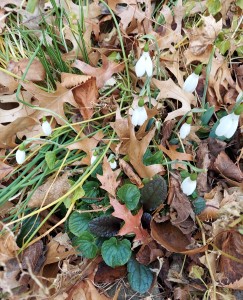Every year in early to mid December, a few snowdrops or galanthus pop up in the little bed by my back porch steps. Depending on your perspective, they are either the last flowers of the old season or the first flowers of the new season. I prefer to think of them as a reminder that there is still a lot going on in the “sleeping” garden. If the weather has been especially awful, I see them as a sign of better things to come.
After all, when the earliest snowdrops appear, the Winter Solstice is only a few weeks away, and with it, the gradual return of daylight. That alone is something to look forward to.
In my part of the world December doesn’t usually bring the worst of storms and snow. We get pelted with those seasonal bombardments in January and February. The earliest blooming snowdrops usually have a fighting chance in December and are well worth the investment.
With inspiration in short supply this year, I decided that in the future I want more early snowdrops. I set about investigating the genus for available species and varieties. Sadly, my early bloomers were planted long ago and the tag has disappeared. An educated guess is the best I can do as far as identifying them.
If you don’t know galanthus, you are missing something important. Though they top out at only about six inches tall, snowdrops belong to the same plant family as that towering holiday amaryllis or hippeastrum that many of us have in our houses right now. Native to western Asia and Eastern Europe, depending on species, snowdrops often feature slender, grass-like leaves. The flowers are borne at the tops of the stalks and dangle daintily from short pedicels. Each one features three outer petals that often look like little wings or propellers. The inner petals are shorter and harder to see, but may have green or yellow markings. The most popular snowdrop, Galanthus nivalis, features white flowers, but less common varieties may boast greenish or even yellow blooms.
Snowdrops are having a moment in the sun right now, with breeders working on new and sometimes improved varieties. Collectors have seized on the genus and new introductions sometimes go for outrageous sums.
I am not interested in mortgaging my house for a snowdrop, but I do want the earliest varieties. By doing a little research I found that many snowdrop aficionados like Galanthus reginae-olgae, or Queen Olga’s snowdrop. The real Queen was a nineteenth century Russian princess who married the King of Greece, was briefly regent of that country, and later exiled. Most likely the snowdrop acquired its regal name because it is native to Greece.
The snowdrop “queen” is a beautiful thing, with a thin silver strip running down each long leaf, and prominent inner petals that feature heart-shaped green markings. “Queen Olga” is also fragrant. In mild climates it may come up in late fall, but it is more realistic to expect it sometime between Thanksgiving and Christmas. The Royal Horticultural Society has bestowed its Award of Garden Merit—AGM—on Galanthus reginae-olgae.
Galanthus atkinsii or Atkin’s snowdrop is another AGM winner. The flowers have longer outer petals than those of Queen Olga’s snowdrop, but share the heart-shaped greenish-yellow marking on the inner petals. Like many later-flowering snowdrops, the blooms smell like honey. When the Atkin’s snowdrop is happy, it also naturalizes and spreads readily.
Hailing from Turkey, Elwes’ galanthus or Galanthus elwesii, has broad oval petals, which completely hide the small, green-marked interior ones. It may come a little later than Queen Olga’s namesake, but the flowers are every bit as beautiful.
Galanthus in general like well-drained soil in full sun to part shade. Being spring “ephemerals”, they sprout, flower, set seed and disappear before early summer. The autumn flowering varieties, like mine, disappear long before that. Snowdrops flourish under deciduous trees because the blooms have come and gone before tree leaves even think of appearing.
Obtaining all but the most common snowdrop plants or bulbs can be frustrating for Americans, because the best suppliers are in Great Britain. I buy mine from the wonderful Hitch Lyman at The Temple Nursery. Hitch puts out a catalog once a year, full of wonderful varieties, including early-blooming plants. Be forewarned, though, the catalog is not available online, has no order form and The Temple Nursery does not take credit cards. Write to Mr. Lyman at P.O. Box 591, Trumansburg, NY 14886 and request a catalog. If you decide to make an order, put your request in another letter and enclose a check for the cost of the snowdrops plus S&H. The plants will be harvested “in the green”, just as they have finished blooming, and will be sent to you in spring. Immediate planting is required for best results.
A good source of more common galanthus bulbs is Brent and Becky’s Bulbs in Gloucester, VA. Find them at 7900 Daffodil Lane, Gloucester, VA 23061, (877) 661-2852, www.brentandbeckysbulbs.com. Print catalog available. Order in March for fall delivery and blooms early next fall or early spring.

